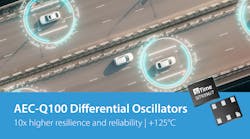SiTime’s SiT9396/7 Automotive Oscillators Address Timing for ADAS
Because ADAS systems rely on an enormous amount of sensor data for safe, autonomous operation, it is important that the data is transferred reliably and timely so that the computers in autonomous vehicles can make life-saving decisions in demanding environments and extreme road conditions.
Features of the SiT9396/7 oscillators include:
AEC-Q100 Grade 1 temperature range (-40°C to 125°C); Grades 2 and 3 also available
- ±30 ppm stability for system performance in hostile environments
- 20x better vibration sensitivity
- small package at 2 x 1.6 mm
- flexible programmable features: 1 MHz to 920 MHz, 1.8 to 3.63 V
- 1 billion hours MTBF
A Range of Output Drivers Offers More Options
The oscillators are based on the company’s silicone MEMS technology, which SiTime’s press release says guarantees failsafe operation of ADAS computers, domain/zone controllers, radar and LiDAR subsystems.
A range of differential output drivers—including low-voltage positive emitter-coupled logic (LVPECL), low-voltage differential signaling (LVDS), high-speed current steering logic (HCSL) and low-power HCSL, and FlexSwing—give developers output options for their automotive systems designs.
READ MORE: A Successful Digital Transformation Hinges on Values | Machine Design
“As more cars are equipped with ADAS technologies, precision timing becomes a critical component for safety,” said Piyush Sevalia, executive vice president of marketing at SiTime, in the company press release. “SiTime’s automotive-grade timing solutions mitigate safety and reliability challenges…SiTime continues to expand its SAM and delivers higher performance levels to our automotive customers. We work with leading EV (electric vehicle) OEMs today to deliver autonomous driving innovations that are redefining how we drive, navigate and experience our cars.”
READ MORE: Digital Transformation: Diverse Companies, Common Strategies | Machine Design

